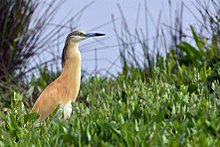Black heron
| Black heron | ||||||||||||
|---|---|---|---|---|---|---|---|---|---|---|---|---|

Black heron ( Ardeola ralloides ) |
||||||||||||
| Systematics | ||||||||||||
|
||||||||||||
| Scientific name | ||||||||||||
| Ardeola ralloides | ||||||||||||
| ( Scopoli , 1769) |
The Rallenreiher ( ardeola ralloides ) is a Old World bird of the genus ardeola from the family of Heron (Ardeidae). In Central Europe , the black heron is only a breeding bird in Hungary and the population in Slovakia varies greatly . In the northern part of Lake Skadar in Montenegro there is a larger population in summer.
features
The 40 to 49 cm long gray heron reaches a weight of 250 to 300 g with a wingspan of 71 to 80 cm. On the ground, the plumage of the thick-necked bird appears inconspicuously ocher-yellow-brown in color. In flight it shows the showy white wings and the white tail. In the plain dress , the squared heron has clear dotted lines on the head and neck sides, a matt ocher-brown coat, and greenish-yellow legs and beak, the latter with a darker tip. In its splendid dress , the bird has elongated neck feathers, a roll yellow, almost unstriped neck, an ocher-brown coat with a light purple sheen, coral-red legs and a green-blue beak with a black tip. The young bird is darker in color with stronger dashes.
Occurrence
The black heron breeds in freshwater swamps and wetlands with reed beds and riparian plants locally in the Mediterranean area , as well as in southwest Asia , Morocco and Ethiopia . In September and October it moves further into Africa, but some individuals hibernate in the southern Mediterranean. When retreating to the breeding areas in April and May, some animals fly further north to the North Sea area . (See: Zugprolongation ) Thus, black herons can be observed in Central Europe until late summer. However, regular broods are only known from Hungary.
behavior
The crepuscular heron, which is active at twilight, hunts insects , frogs and small fish in thick bushes or in the reeds . Outside of the breeding season, the bird lives solitary or in small groups and defends its feeding ground against other conspecifics.
Reproduction
The black heron breeds in colonies once a year from April to June, also together with other heron species, ibis and pygmy shags . In Madagascar, the thick-billed heron and the black heron formed large breeding colonies together. The nests of the black heron were usually below those of the big-billed heron. However, these large colonies have become very rare since the great-billed heron populations plummeted.
The nest made of grass and reed stalks is hidden in the reed or in half-height trees. Both parent birds incubate the four to six eggs and feed the young birds, which fledge at 45 days.
Hazardous situation
The International Union for Conservation of Nature IUCN classifies the black heron as "not endangered" ( Least Concern ). Although the population seems to be declining, the overall very extensive population with a low decline trend and the very large distribution area prevent a poorer classification.
The total European population is estimated at 18,000 to 27,000 breeding pairs. The largest populations are found in Romania (5,500 to 6,500 breeding pairs), Turkey (4,000 to 6,000 breeding pairs), Azerbaijan (2,500 to 5,000 breeding pairs) and Russia (1,500 to 2,000 breeding pairs). 300 to 410 breeding pairs breed in Hungary. It is believed that black herons brooded in the Netherlands until around 1860. The endangerment of this species results mainly from the destruction of wetlands. The decisive factor here is the loss of reed stocks and the destruction of floating plant communities as well as the old wood stocks bordering water bodies. Similar to the little bittern , the persistent drought in the Sahel zone, which affects the chances of survival in the resting and wintering areas, can also contribute to the continuing decline of the species .
supporting documents
literature
- Hans-Günther Bauer, Einhard Bezzel and Wolfgang Fiedler (eds.): The compendium of birds in Central Europe: Everything about biology, endangerment and protection. Volume 1: Nonpasseriformes - non-sparrow birds. Aula-Verlag Wiebelsheim, Wiesbaden 2005, ISBN 3-89104-647-2 .
- Rob Hume Birds in Europe. Dorling Kindersly Limited, London 2002, ISBN 3-8310-0430-7 .
- James A. Kushlan & James A. Hancock: Herons . Oxford University Press, 2005, ISBN 0-19-854981-4 .
- Anne Puchta & Klaus Richarz: Steinbach's great bird guide. Eugen Ulmer KG, Stuttgart 2006, ISBN 3-8001-4864-1 .
- Svensson, Grant, Mullarney & Zetterström: The new cosmos bird guide. Franckh-Kosmos Verlags-GmbH, Stuttgart 1999, ISBN 3-440-07720-9 .
Web links
- Videos, photos and sound recordings of Ardeola ralloides in the Internet Bird Collection
- Age and gender characteristics (PDF; 0.9 MB) by J. Blasco-Zumeta and G.-M. Heinze (eng.)
- Northern heron feathers
Single receipts
- ↑ Kuhlan et al., P. 247
- ↑ Ardeola ralloides in the endangered Red List species the IUCN 2009. Posted by: BirdLife International, 2009. Accessed on March 10 of 2010.
- ^ Bauer et al., S: 257
- ↑ Bauer et al., P. 257


